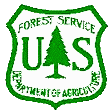
Chapter 3
Ecological Subregions of the United
States
| Back |  |  Contents |  | Forward |
 | Chapter 3 |
|
Bering Tundra (Southern)
One Section has been delineated in this Province:126A--Bristol Bay Lowlands.
This Section, located in southwestern Alaska, includes part of the Alaska Peninsula. Its area is about 23,600 mi2 (61,100 km2).
Section 126A--Bristol Bay Lowlands
Geomorphology. This Section is a flat-to-rolling moraine and outwash-mantled lowland. The source of the material is from surrounding glaciated mountains. Elevation is generally less than 500 ft (150 m).Lithology and Stratigraphy. The lowland is underlain by several hundred feet of outwash and morainal deposits that are mantled in part by silt and peat. Outwash deposits are coarse near the mountains and grade to fine sand along the coast. A small area of low stabilized and active dunes lies east of the Nushagak River.
Soil Taxa. Dominant soils are Typic Haplocryands, Fluvaquentic Cryofibrists, Typic Vitricryands, Histic Pergelic Cryaquepts, Pergelic Cryaquepts, and Typic Cryochrepts. Most soils formed in ash deposits of various thickness underlain by gravelly glacial till, outwash deposits, or silty alluvium. Coastal plain soils have gravelly alluvium, cinders, or weathered rock blanketed by thick sedge peat.
Potential Natural Vegetation. Moist and wet tundra meadows are the dominant vegetation. Mosses, sedges, and low-growing shrubs cover most of the area. Alder and willows and, in scattered places, stunted spruce and birch grow along the major rivers and streams.
Fauna. Bristol Bay provides staging and migration habitat for large numbers of waterfowl. Ospreys occur more frequently in this Section than in other areas of Alaska. Blackpoll warblers are common breeders in conifer stands in the northern portion. Brown bears are common, partially in response to the large salmon runs in this area. Bristol Bay supports the largest run of sockeye salmon in the world. Rainbow trout are a common resident fish in the northern part of this Section.
Climate. Average annual precipitation ranges from 18 to 32 in (460 to 810 mm). Average annual temperature ranges from 30 to 37 _o_F (-1 to 3 _o_C). The growing season is approximately from May 15 to September 10.
Surface Water Characteristics. Morainal and thaw lakes and ponds are scattered throughout the lowlands and make up about 15 percent of the Section. Most streams arise from the nearby mountains, and many have headwaters comprised of lakes in ice-carved basins. Permafrost is limited to isolated masses. Wetlands occupy 55 percent of the area.
Disturbance Regimes. The occurrence of wildfires is low.
Land Use. Permanent settlements occur primarily along the coast or adjacent to the larger rivers.
Cultural Ecology. Yupik and Alutiiq Eskimos occupy the northern and southern portions of this Section, respectively.
Compiled by Alaska Region.
Top
Back
ContentsForward